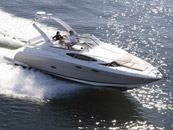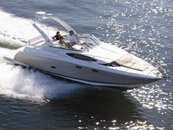A little TLC makes all the difference in staying warm.
By Peter Frederiksen
By far, some of the hardest working gear aboard a boat is its fabric and clear vinyl enclosures. On the job 24/7, an enclosure endures sun, air pollution, rain, salt spray and bird droppings while protecting you, your vessel and your equipment from the harsh marine environment. The protection afforded by a good enclosure can also extend your boating season and allow you to get more use and value from your boat. Fishermen in the Northeast, for example, can get their last licks in as the leaves turn orange and the striped bass turn on.
But in spite of its many on-board assignments, the enclosure does not always get the respect it deserves. Since an enclosure can cost several thousand dollars, it makes sense to take care of it. I have had enclosures on my boats last for years, yet I have seen some enclosures on boats in my marina ruined after a single season by careless skippers. These boat owners did not bother to replace the missing fasteners that secure the enclosure and, as a result, wind whipped the material into shreds.
Clean Machine
Although many mariners refer to enclosures as canvas, modern enclosures are usually fabricated from synthetics. These materials are far more durable, weather-resistant and colorful, which makes them popular with today’s boaters. The key to maintaining these materials is simple: Keep them clean as part of your routine boat maintenance. After a day on the water, don’t overlook the enclosure when washing your boat. Enclosures should be sprayed lightly with fresh water to rinse away any salt or dirt accumulated during the day, as well as any that collected during the week when the boat was at the dock.
When rinsing, I like to use a nozzle that sprinkles like a shower head because a hard stream of water can drive and grind dirt and salt into the fabric and threads, thereby weakening them. Follow this rinse with gentle strokes from a soft-bristle brush dipped in a sudsy solution of water and a mild soap. Rinse again, and let the material air-dry. If you are washing a Bimini top or T-top, be sure to clean the underside as well.
Any salt left behind will eventually attract moisture and the material will become a breeding ground for mildew. You can counter this by adding non-chlorine bleach to the soapy solution when needed. Use plenty of water to rinse thoroughly afterward, as residual bleach can eventually damage some types of stitching. If the Bimini top stows in a boot, be absolutely sure it is completely dry before rolling it up. Occasionally, wash the boot as well. Follow these same cleaning and care procedures when storing your enclosure or Bimini top for the off-season.
Enclosure fabrics are treated to repel water and do so for years. However, if rain no longer beads up on the surface of the enclosure, apply a spray fabric guard to restore its repellency. Call a local canvas shop before attempting this to get their recommendations on what is compatible with the material on your boat.
See Clearly
Clear vinyl panels used with enclosures require their own special care. The clear panels are made from flexible vinyl that rolls up to bring the breeze aboard, or rigid acrylics with fold-up panels. These materials are durable and provide excellent visibility when new, but need proper cleaning and regular care to maintain clarity.
Hard streams of water and dirty cleaning mitts are two of a clear panel’s biggest enemies. A direct and forceful stream of water hitting the clear panels can etch salt or grit into the surface like a sand blaster. As with cloth materials, gently spray the entire panel to remove dirt and dried salt.
I use a dedicated white cotton terry cloth mitt when washing clear panels. This prevents the transference of any boat grime like fish blood or transom soot to the panels, which could lead to scratches. Again, use that mild soap solution followed by a generous but gentle rinse of fresh water.
I do not like to use boat wash and wax soaps because the ingredients can often leave behind a film that discolors the clear panels after prolonged exposure to sunlight. Similarly, cleaners, pine soaps or similar strong detergents can dull the surface. It is very important to rinse the panel immediately after applying the soapy mitt. You do not want the soap to dry on the panel.
I also employ a dedicated chamois to dry the clear panels, or you can use a vinyl wiper blade. The key is to dry the panels before the water has a chance to evaporate since chemicals or minerals in the water are likely to leave behind annoying spots that are troublesome to remove. Spotting can also result when harsh sunlight heats up beads of water left behind after rinsing. You want to avoid leaving a wet enclosure rolled up for the same reason.
20/20 Vision
While sunlight can fade enclosure fabrics, these materials retain their usefulness until worn out. The same is not true for clear panels, which degrade over time due to exposure to ultraviolet sunlight. To protect the clear vinyl or hard acrylics and preserve good visibility, it is necessary to occasionally treat the materials with special cleaners and polishes a few times each season.
It is important to understand that soft vinyl and hard acrylics are unique products and require specialized cleaners and polishes. You should only use those recommended by the manufacturer of your enclosure. If you have a new boat, the information is likely found in the owner’s manual. The wrong cleaner can cause damage beyond repair.
I once treated my enclosure with a windshield treatment, and within a week the panel fogged up beyond belief. Fortunately, I suppose, I only ruined part of one panel because I applied the windshield treatment to a small area to gauge the results. The enclosure is a flexible vinyl with a pressed UV coating that blocks the sun’s rays and offers extra protection against scratching. The windshield treatment reacted with the coating and caused the fogging. Less expensive isinglass lacks this extra layer and can be cleaned with various plastic cleaners and then protected with premium liquid insulator wax or fiberglass boat wax with good results.
After washing the enclosure, treat the panels with protective polish every one to two months. Use the protective cleaner for routine cleaning between polishing.
Hard acrylics are extremely durable. They require little more than regular washings and occasional applications of pure wax scratch remover is effective to clean small scratches. When working on panels, always start with clean applicator pads or sponges and clean cotton towels for buffing polish and wax. Never use paper towels because minute traces of wood products in the paper can lead to scratches.
Shared with permission by MotorBoating.


